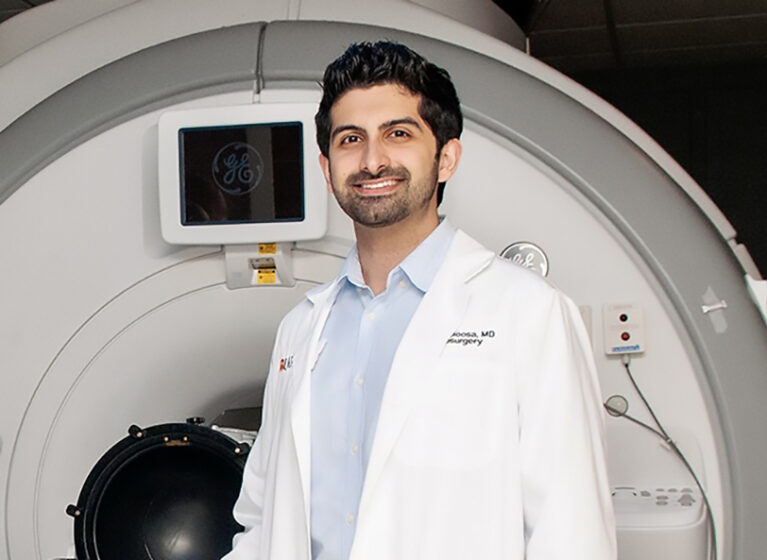
What if a surgical treatment for cancer could be performed without a scalpel? What if it required little to no downtime or side effects? What if it was finished in less than an hour? And what if these questions could be answered, specifically, for a cancer as difficult to treat as glioblastoma?
For decades, glioblastoma has been a death sentence despite researchers’ best efforts. However, as a national leader in cancer research and treatment, new research at UVA Health could finally lead us to better outcomes for these patients.
UVA Health neurosurgeon Shayan Moosa, MD, is leading this ambitious effort. In a groundbreaking phase 1 clinical trial, Moosa and his team will assess the impact of sonodynamic therapy — a combination of focused ultrasound and a targeted drug — to treat patients with recurrent glioblastoma.
Focused ultrasound technology, pioneered at UVA Health, was a game changer for treating essential tremor and other neurological conditions. Now, it could help treat glioblastoma.
“We hope this gives a new option to patients with brain tumors,” says Moosa. “Glioblastoma and other aggressive cancers will inevitably recur, and sonodynamic therapy can supplement our current treatment regimen to potentially provide a longer interval before disease progression, as well as to treat recurrent tumors in a noninvasive fashion.”
In addition to neurosurgeons, the glioblastoma research team brings together neurooncologists, neuroradiologists, pathologists, biomedical engineers, and more. Their research builds on UVA Health’s pioneering use of focused ultrasound to successfully treat essential tremor and other movement disorders.
How Glioblastoma Eludes Surgeons
The current standard of care for glioblastoma is surgery on the primary tumor. But because cells from the primary tumor spread quickly throughout the brain, physicians cannot remove them all surgically.
“Glioblastoma is one of the most common primary brain cancers, but there is no cure for it,” says Moosa. “Even with a combination of surgery, radiation, and chemotherapy, we cannot eliminate all the cancerous cells. As a result, the average life expectancy for patients with glioblastoma is just 15 months, and that number has not changed significantly despite recent innovations in cancer treatment.”
Moosa’s research may offer a solution. Sonodynamic therapy can potentially halt glioblastoma’s spread by improving doctors’ ability to destroy cancer cells while keeping the rest of the brain safe.
“This treatment has the potential to be a game changer for glioblastoma patients,” says Moosa. “Sonodynamic therapy is deadly to cancer cells but safe for the brain.”
Eventually, Moosa hopes that this therapy can help treat multiple areas of the brain, though the current trial is specific to the main tumor area.
Sonodynamic Therapy: Quick & Safe for Patients
While new to glioblastoma treatment, focused ultrasound, a technology researched and accelerated at UVA Health, has had other use cases, including ablation of brain structures. In the case of glioblastoma treatment, sonodynamic therapy utilizes a combination of treatments, including focused ultrasound and 5-aminolevulinic acid (5-ALA), a drug designed for visualizing tumors during surgery.
After physicians administer the drug, which is safe for normal brain tissue, it collects specifically in tumors. These tumors containing 5-ALA are then subjected to focused ultrasound energy. This results in a targeted cytotoxic effect to tumor cells.
“This therapy has been studied in preclinical models, and we are optimistic about bringing it to humans to treat glioblastoma,” says Moosa. “For this study, we have obtained FDA approval to study a new device for delivering ultrasound energy. This device uses advanced neuronavigation computer systems to track the delivery of ultrasound without having to put the patient in an uncomfortable head frame or MRI scanner.”
Moosa’s phase 1 trial focuses on treating patients with recurrent glioblastoma who have had surgery before. They will complete sonodynamic therapy before a standard-of-care surgical treatment a few weeks later.
Moreover, this procedure is expected to be quick, safe, and noninvasive. Patients, who are awake during the 1-hour procedure, may experience sensitivity to light, and the ultrasound may cause mild heating on the skin, but these risks are significantly lower than those for glioblastoma resection.
Building on Pioneering Noninvasive Brain Treatment
Focused ultrasound offers hope for treating the brain noninvasively in a myriad of ways. This includes thermal ablation, histotripsy, blood brain barrier opening, sonodynamic therapy, and neuromodulation, to name a few. Many of these techniques are being studied at UVA Health to eventually treat patients with brain tumors, movement disorders, chronic pain, epilepsy, psychiatric disorders, and neurodegenerative disorders.
“Focused ultrasound has been a primary interest at UVA Health, and this technology was pioneered here for the treatment of essential tremor and Parkinson’s disease,” says Moosa. “In addition, UVA Health is home to the world’s first Focused Ultrasound Cancer Immunotherapy Center.”
Further studies will focus on bringing the research to the clinical side and progressing the therapy through later clinical trial stages. Additionally, while Moosa’s research has focused on glioblastoma, other teams at UVA Health are working on clinical trials to see if focused ultrasound holds promise for other forms of cancer in the brain and elsewhere in the body.
Learn more about this clinical trial.